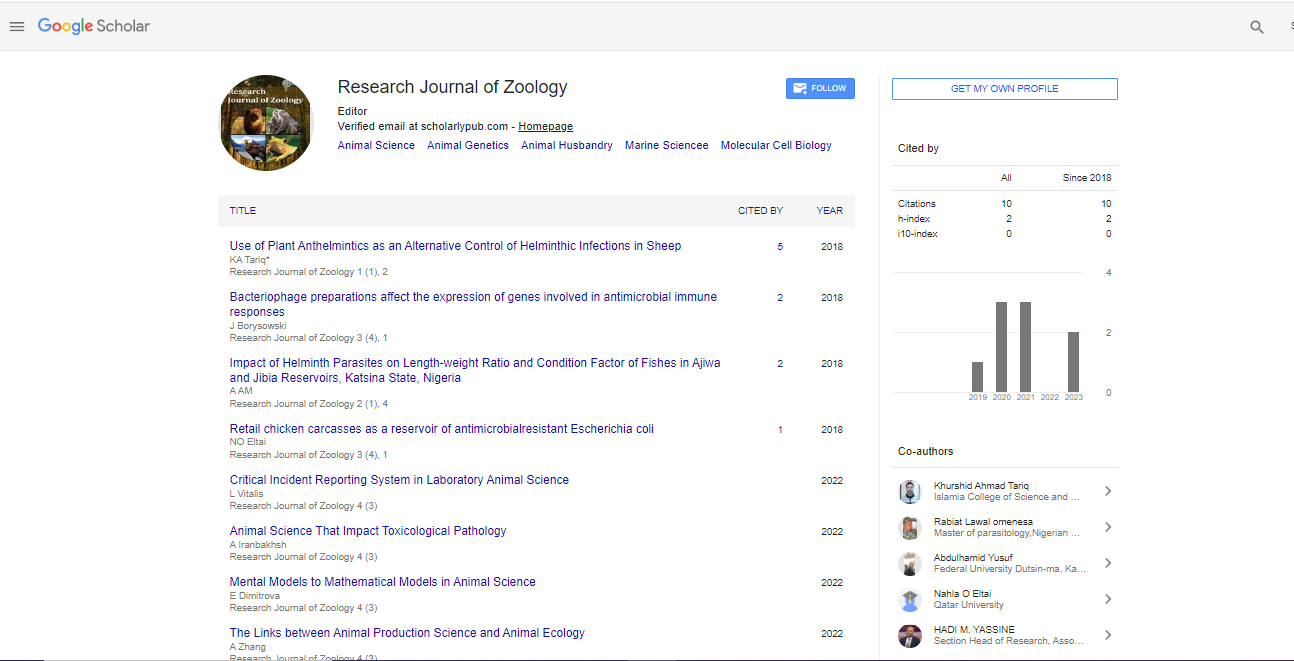Perspective, Res J Zool Vol: 5 Issue: 2
Genomic Insights into the Evolution of Venomous Snakes and Lizards
Daniel Wolny*
1Department of Zoology, The University of British Columbia, Vancouver, Canada
*Corresponding Author: Daniel wolny,
Department of Zoology, The University of
British Columbia, Vancouver, Canada
E-mail: danielwol2@ubc.ca
Received date: 30 August, 2023, Manuscript No. RJZ-23-118072;
Editor assigned date: 01 September, 2023, PreQC No. RJZ-23-118072 (PQ);
Reviewed date: 15 September, 2023, QC No. RJZ-23-118072;
Revised date: 22 September, 2023, Manuscript No. RJZ-23-118072 (R);
Published date: 29 September, 2023 DOI: 10.4172/rjz.1000082.
Citation: Wolny D (2023) Genomic Insights into the Evolution of Venomous Snakes and Lizards. Res J Zool 5:2.
Description
The evolution of venomous snakes and lizards has long intrigued scientists and herpetologists. These remarkable reptiles have developed complex venom systems over millions of years, enabling them to subdue prey and defend themselves. Recent advances in genomics have provided a new lens through which researchers can explore the genetic underpinnings of venomous adaptations, shedding light on the fascinating evolutionary history of these animals. Venomous reptiles, which include various snake and lizard species, have evolved a diverse array of toxic cocktails. Venom is typically a complex mixture of proteins, peptides, and other molecules that vary greatly between species. It is primarily used for predation, allowing these reptiles to immobilize, digest, and eventually consume their prey. Venom also plays a crucial role in self-defense, acting as a potent deterrent against potential threats.
Genomic research has played a pivotal role in unraveling the intricate evolution of venomous adaptations. By comparing the genomes of venomous and non-venomous species within the same families or genera, scientists have been able to identify key genetic changes associated with the development of venomous glands, venom production, and venom delivery mechanisms. One of the most striking genomic insights into venomous snakes and lizards is the rapid evolution of venom genes. These genes often show a high degree of divergence, even among closely related species. This suggests that the evolution of venom is driven by strong selective pressures, likely associated with changes in prey type, predator avoidance, and competition for resources. Venom genes encode for various components of venom, including toxins and enzymes that perform functions such as immobilizing prey or breaking down tissue. Genomic studies have also revealed that the evolution of venomous adaptations frequently involves the recruitment of existing genes for venomous purposes. Many venomous proteins are derived from nonvenomous ancestral proteins, repurposed through gene duplication and neofunctionalization. This process allows for the rapid innovation and diversification of venom components.
Venomous snakes and lizards possess unique delivery systems to effectively inject venom into their prey or attackers. Genomic analyses have highlighted the genetic basis for the development of specialized venom delivery structures, such as fangs in snakes or grooved teeth in certain lizard species. The evolution of these structures is closely linked to the development of venom and its efficient use in capturing or deterring adversaries. Another intriguing aspect of the genomic insights into venomous reptiles is the phenomenon of convergent evolution. Different lineages of snakes and lizards have independently evolved venomous systems, even though they may not be closely related. Genomic studies have shown that these convergent adaptations involve similar genetic changes, suggesting that the evolution of venom is constrained by certain genetic pathways and structural components. This phenomenon not only underscores the power of natural selection but also hints at the remarkable adaptability of reptiles to their ecological niches.
Beyond the fascinating insights into the evolutionary history of venomous snakes and lizards, this research has practical applications. Understanding the genomic basis of venom production and delivery can have implications for human health and medicine. Many venomous reptile toxins have bioactive components that may hold the key to developing novel pharmaceuticals, including pain relief and anti-coagulants. Moreover, this knowledge can inform the development of antivenoms, essential for the treatment of snakebites and envenomations.
Genomic insights into the evolution of venomous snakes and lizards have illuminated the remarkable adaptations these reptiles have undergone over millions of years. The rapid evolution of venom genes, the recruitment of non-venom genes, and the convergent evolution of venomous systems showcase the power of natural selection in shaping these reptiles' unique predatory and defensive abilities. Furthermore, the practical applications of this research make it not only intellectually captivating but also highly relevant to human well-being. As our understanding of the genomics of venomous adaptations deepens, it promises to reveal even more about the intricate dance of evolution in the animal kingdom.
 Spanish
Spanish  Chinese
Chinese  Russian
Russian  German
German  French
French  Japanese
Japanese  Portuguese
Portuguese  Hindi
Hindi 
